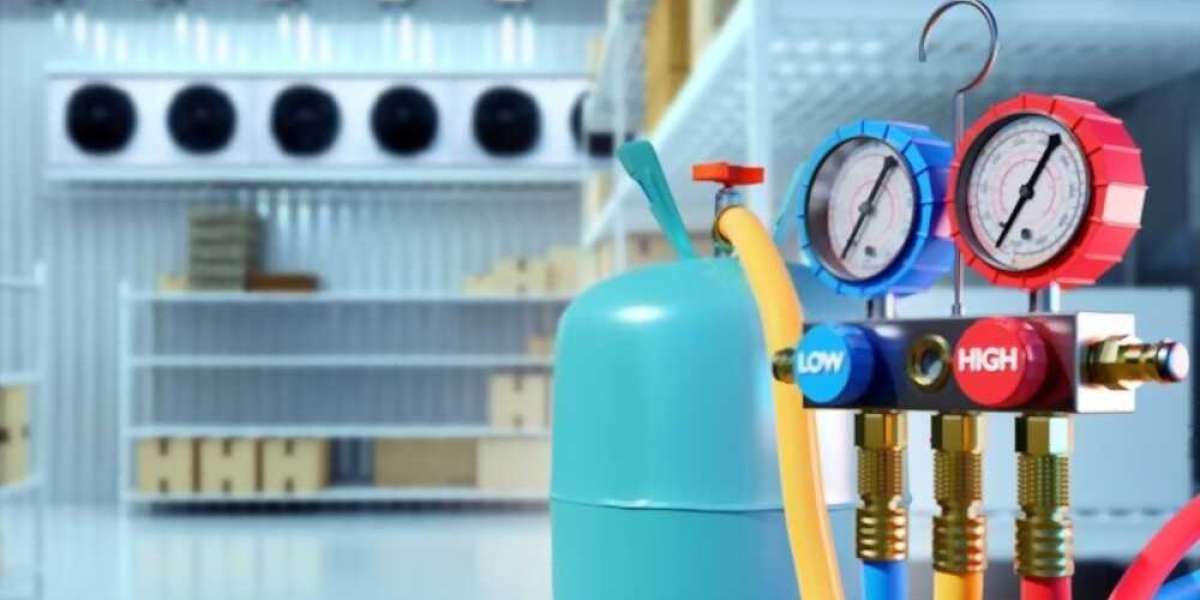R404A refrigerant is a commonly used refrigerant in low and medium-temperature refrigeration applications. However, due to its high Global Warming Potential (GWP), it is being phased out and replaced with refrigerants that have a lower GWP.
The Function of R404A Refrigerant
R404A refrigerant plays a crucial role in low and medium-temperature refrigeration applications by absorbing heat from the environment and transferring it to the condenser, where it is released into the atmosphere. This refrigerant is a blend of HFC refrigerants R125, R143a, and R134a, each contributing to the refrigerant's thermodynamic properties, such as boiling point, critical temperature, and pressure. Consequently, R404A is suitable for use in a wide range of commercial refrigeration systems, including cold storage, supermarket refrigeration systems, and ice rinks.
The refrigeration process begins when R404A enters the evaporator, a heat exchanger in contact with the environment to be cooled. As the refrigerant flows through the evaporator, it absorbs heat from the environment, causing it to evaporate and become a low-pressure gas. The low-pressure gas flows to the compressor, where it is compressed and converted into a high-pressure gas. The high-pressure gas then flows to the condenser, another heat exchanger in contact with the atmosphere, where it releases heat into the atmosphere, causing it to condense back into a liquid. The liquid refrigerant then flows through an expansion valve, reducing its pressure and temperature, and the cycle starts again.
Phasing Out R404A Refrigerant
The phasing out of R404A refrigerant is in response to increasing concerns about climate change and its impact on the environment. The EU F-gas Regulation, No 517/2014, aims to reduce emissions of fluorinated gases, including hydrofluorocarbons (HFCs) that have a high GWP. The regulation prohibits the construction of fixed refrigeration units that use refrigerants with a GWP of over 2500. As a result, new R404A plants are no longer permitted as of the beginning of 2020.
Replacement Options for R404A Refrigerant
Alternative refrigerants for R404A include natural refrigerants such as ammonia (NH3) and carbon dioxide (CO2), which have a GWP of zero. New replacement refrigerants such as R1234yf and R1234ze also have a lower GWP of less than 10. The choice of replacement refrigerant depends on the system and purpose of use. For example, ammonia is commonly used in large industrial refrigeration systems, while R1234yf is used in automotive air conditioning systems.
Replacing R404A refrigerant with a lower GWP alternative may require modifications to the existing system. For example, ammonia is not compatible with certain materials used in some refrigeration systems, and carbon dioxide requires higher operating pressures than R404A. Therefore, it is important to consult with a qualified technician or refrigeration engineer before making any changes.
Applications
R404A refrigerant is commonly used in commercial and industrial refrigeration equipment, freezers, refrigerated display cabinets in grocery shops, and some ice stadiums. As it is being phased out, it is important to consider alternative refrigerants for these applications. Some refrigeration systems may require a complete retrofit, while others may be able to switch to a lower GWP alternative refrigerant without significant modifications.
R404a Refrigerant Price
The cost of R404A refrigerant has increased over the years, and the phasing out will likely increase its price further. This makes it even more important to consider alternative refrigerants that have a lower GWP value and are more environmentally friendly. However, the cost of retrofitting or replacing a refrigeration system must also be taken into account.
R404A vs R134a - Which Refrigerant is Better?
When choosing the suitable refrigerant for your cooling system, you may wonder which one is better - R404A or R134a. Both refrigerants are commonly used in low and medium-temperature refrigeration applications. However, there are some key differences between the two.
R404A is a blend of HFC refrigerants R125, R143a, and R134a. It is commonly used in commercial refrigeration equipment such as cold storage, supermarket refrigeration systems, and ice rinks. It has a GWP of 3,922, which means it is a potent greenhouse gas and can contribute significantly to global warming.
R134a, on the other hand, is a single-component refrigerant widely used in automotive air conditioning systems and some commercial refrigeration systems. It has a lower GWP of 1,430, making it a less potent greenhouse gas than R404A.
Can I Use R410A Instead of R404A?
R410A is a refrigerant that is commonly used in air conditioning systems. It is a blend of HFC refrigerants R32 and R125, and it has a GWP of 2,088. R404A, on the other hand, is commonly used in low and medium-temperature refrigeration applications and has a GWP of 3,922.
While R410A and R404A have similar boiling points and thermodynamic properties, they are not interchangeable. The use of R410A in a refrigeration system designed for R404A can result in poor performance and equipment failure.
In addition, the use of R410A in commercial refrigeration systems is not permitted under the EU F-gas Regulation No 517/2014, which prohibits the use of refrigerants with a GWP of more than 2500 in new commercial refrigeration equipment.
Conclusion
Phasing out R404A refrigerant is a step towards reducing the impact of climate change on the environment. It is important to consider alternative refrigerants that are more sustainable in the long run. By doing so, we can work towards a more sustainable future for generations to come. However, choosing a replacement refrigerant requires careful consideration of the system and purpose of use, as well as the cost of retrofitting or replacing the existing system. Consultation with a qualified technician or refrigeration engineer is recommended to ensure a smooth transition to a lower GWP alternative.



